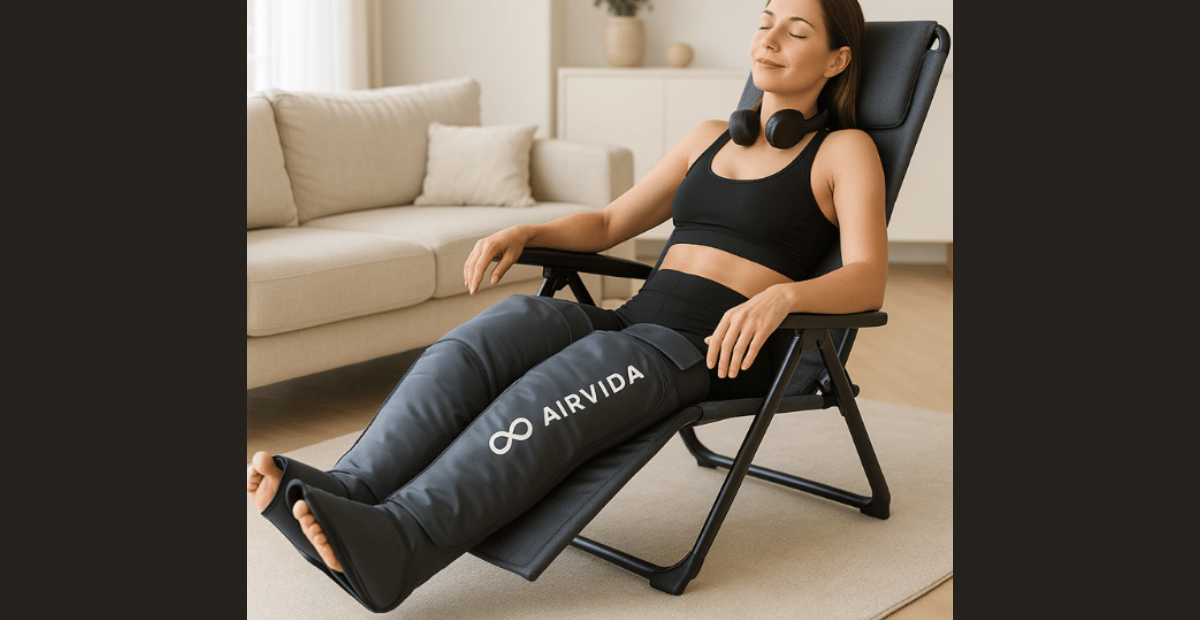Leg compression machines are becoming more popular for good reason, but do they actually work? If you’ve been on the fence about trying one, this guide is for you. We’ll break down how they function, what benefits they offer, and why so many people are turning to them for better recovery, circulation, and comfort.
Whether you’re dealing with swelling, tired legs, or simply want to upgrade your wellness routine, let’s dive into how these machines perform.
What Are Leg Compression Machines?
Leg compression machines use inflatable air chambers that rhythmically squeeze and release pressure on your legs. This helps push blood and lymphatic fluids back toward the heart, mimicking the natural muscle pump your body relies on for healthy circulation.
At Airvida Chambers, these devices come in various models, offering segmented leg wraps, adjustable pressure levels, and cycle settings tailored for different wellness needs.
Do Leg Compression Machines Really Work?
Short answer: Absolutely. These machines are clinically backed for improving venous return, reducing swelling, and speeding up muscle recovery. The rhythmic compression stimulates circulation, supports lymphatic drainage, and relieves fatigue caused by prolonged sitting, standing, or intense activity.
They’re especially helpful for:
-
People with poor blood flow
-
Athletes recovering from workouts
-
Individuals managing chronic swelling or lymphedema
-
Office workers or frequent flyers experiencing leg heaviness
Daily use for just 15–30 minutes can lead to noticeable improvements in comfort, energy, and performance.
Benefits of Using a Leg Compression Machine
Here’s what consistent users report:
-
Improved circulation: Helps blood return to the heart, reducing leg fatigue and heaviness.
-
Faster recovery: Post-exercise or post-surgery, they help flush lactic acid and reduce soreness.
-
Reduced swelling: Ideal for those with edema, lymphedema, or long periods of inactivity.
-
Enhanced relaxation: Many find the experience calming, like a massage for your legs.
-
Preventative wellness: Supports better vascular health and may help reduce the risk of clots.
Medical Uses
-
Deep Vein Thrombosis (DVT) prevention: Intermittent pneumatic compression (IPC) devices reliably reduce DVT risk, clinical trials show about a 4% drop in incidence among immobile patients. These are standard in hospitals for post-surgical or bedridden individuals Bodywork Movement Therapies+7Cleveland Clinic+7Cryon X+7.
-
Lymphedema and fluid reduction: Advanced pneumatic compression devices (APCDs) have demonstrated significant reductions in leg volume, extracellular and intracellular fluid, and pain in women with lipedema, along with improved quality‑of‑life scores over a 30‑day period PubMed+2MDPI+2.
Sports & Recovery
-
Post‑workout recovery: Athletes use compression boots to reduce swelling, enhance circulation, and relieve soreness. Studies suggest short‑term relief from muscle fatigue and improved cardiovascular recovery. Effects vary, though, and some improvements may be no better than a placebo or less effective than active recovery (like light cycling).
Leg compression machines deliver professional-grade compression therapy using inflatable cuffs that apply rhythmic pressure, helping improve blood flow, reduce swelling, and accelerate muscle recovery. Available in a variety of designs, from simple air massagers to full-leg, cordless systems, these devices cater to athletes, recovery enthusiasts, and anyone managing circulation issues.
Leg Compression You May Want to Shop
Explore MoreTypes of Leg Compression Machines
1. Air Compression Leg Massagers
These devices use sequential air chambers to gently inflate and deflate around the legs, mimicking the effects of a professional massage. This process improves circulation, speeds up the removal of metabolic waste, and helps relieve muscle fatigue. Whether you're an athlete or someone who sits for long hours.
2. Leg Compression Therapy Machines
Designed for targeted medical and wellness applications, these machines offer customizable pressure levels and treatment durations. Often equipped with intuitive controls and LCD screens, they deliver precise therapy sessions for conditions like lymphedema and chronic venous insufficiency. If you’re looking for effective at-home treatment, explore our leg compression therapy machines for lymphedema and circulation support.
3. Home Leg Compression Machines

Built for at-home use, these compact, user-friendly units deliver clinical-grade compression therapy without the need for a clinic visit. They’re perfect for people who want consistent recovery support in the comfort of their home. Key features include cordless operation, adjustable pressure levels, and ergonomic cuffs that wrap securely and comfortably around your legs.
Whether you're recovering from intense workouts, managing swelling, or simply improving circulation, a home leg compression machine for daily recovery and comfort is a convenient and effective solution..
4. Full-Leg Compression Machines
Full-coverage systems are designed to deliver therapy from the feet all the way up through the thighs and quads, offering full-leg support in one session. These machines are especially beneficial for athletes, individuals with circulation issues, or those managing chronic swelling and fatigue across the entire leg. With multiple air chambers and adjustable compression levels, they help improve blood flow, reduce fluid retention, and ease muscle soreness.
Discover the benefits of a full-leg compression machine for complete leg recovery and circulation from the comfort of your home.
5. Automatic Leg Compression Machines
Automatic models are designed to simplify your recovery routine. They cycle through preset programs, like sequence, circulation, and full-leg modes, without the need for manual adjustments. This hands-free approach makes them ideal for consistent, daily use, especially for those with busy lifestyles or limited mobility.
The intelligent pressure settings adapt to your needs, helping to reduce muscle fatigue, support better blood flow, and manage swelling. If you're looking for a hassle-free solution, consider an automatic leg compression machine for effortless, at-home therapy that works while you relax.
6. Cordless/Battery-Operated Compression Boots
These portable compression boots are perfect for those who want flexibility and freedom during recovery. With no power cords required, they offer up to three hours of use per charge, making them ideal for use at home, at the gym, or even while traveling.
Many models include multiple compression zones, smart pressure sensors, and easy-to-use touchscreen controls that let you customize your therapy session. If you’re looking for a convenient and effective solution, these cordless leg compression boots with an LCD screen provide powerful, targeted relief without tying you down.
Available Leg Compression Machine Model on Airvida Chambers

-
Airvida Cordless Leg Compressions With LCD Screen
-
Wireless, rechargeable full-leg compression boots for ultimate mobility
-
Four compression zones: feet, calves, thighs, and quads
-
Adjustable pressure range (50–200 mmHg) with three modes: Sequence, Circulation, Whole
-
3,200 mAh battery delivering up to 180 minutes per charge
-
Intuitive LCD touchscreen for easy session control
Learn more: Airvida Cordless Leg Compressions With LCD Screen
How Often Should You Use One?
You can use a leg compression machine daily, especially if you’re recovering from intense activity, sitting for long hours, or dealing with circulation issues. Many users notice results in just a few sessions, with ongoing benefits from consistent use.
Suggested use:
-
15–30 minutes per session
-
1–2 times per day, depending on your condition
-
Before or after workouts, or during relaxation time in the evening
When They Work Best
|
Use Case / Condition |
When They Work Best |
Clinical Evidence |
|
Post-Workout Recovery |
Right after intense exercise, to reduce muscle soreness and flush out lactic acid |
Yes – Supported by studies |
|
Poor Circulation |
During long sitting or standing to promote healthy blood flow |
Yes – Backed by vascular studies |
|
Swollen Legs (Edema) |
At the end of the day, or after travel, when fluid buildup is common |
Yes – Common edema treatment |
|
Lymphedema Management |
Daily use as directed by a healthcare provider |
Yes – Clinically prescribed |
|
Varicose Veins Relief |
During discomfort to reduce pressure and improve circulation |
Yes – Recommended by doctors |
|
Chronic Venous Insufficiency (CVI) |
Consistent daytime use to support vein performance |
Yes – Validated in clinical use |
|
DVT Prevention |
During recovery after surgery or extended immobility |
Yes – Hospital protocol use |
|
Athletes / Trainers |
After workouts or training for faster muscle recovery |
Yes – Proven in sports recovery |
|
Elderly Individuals |
Daily or as needed for swelling and comfort support |
Yes – Used in geriatric care |
|
General Wellness |
For relaxation, circulation boosts, and light massage |
Yes – Wellness research supports |
Caveats & Considerations
-
Underlying health conditions: Not recommended for people with untreated fractures, severe peripheral artery disease (ankle-brachial index <1.0), heart failure, or deep tissue infections.
-
Device quality matters: Medical-grade sequential compression systems offer controlled, graduated pressure. Cheaper devices may lack proper sequencing and therapeutic pressure.
-
Effectiveness varies: For general athletic recovery, active forms of movement, walking, light cardio, often outperform passive compression boots.
Is It Right for You?
If you’re asking “do leg compression machines work?” because you’re dealing with:
-
Tired, aching legs
-
Swelling from long hours on your feet
-
Slow muscle recovery
-
Cold feet or poor circulation
Then yes, it’s worth giving it a try. These machines offer a simple, drug-free solution you can use right at home.
Still Wondering: Do Leg Compression Machines Work? Feel the Results Yourself.
Leg compression machines aren’t just hype, they truly work. Backed by clinical research and trusted by athletes, physical therapists, and wellness professionals, these devices deliver real results when it comes to improving circulation, reducing swelling, and speeding up muscle recovery. Whether you’re managing discomfort, recovering from a workout, or simply prioritizing your leg health, compression therapy can be a game-changer.
With Airvida Chambers, you don’t need a clinic visit to get effective treatment. Our carefully selected leg compression machines bring the power of professional therapy straight to your home, easy to use, portable, and built for real results. Invest in your recovery today and discover what better circulation and comfort can feel like.
Ready to Try One?
Explore the full line of leg compression machines at Airvida Chambers. Choose the model that matches your lifestyle and start your journey to better circulation and comfort today.
Recommended Reads:
-
Best Leg Compression Machine: Your Ultimate Guide
Find the right model for your unique needs. -
What Conditions Are Treated with Leg Compression Machines?
Understand how these machines help with lymphedema, DVT, and more. -
What Are the Benefits of Leg Compression Machines?
Dive deeper into how these machines improve your well-being.
Frequently Asked Questions
What does a compression machine do for your legs?
A leg compression machine uses inflatable cuffs to apply gentle, rhythmic pressure to your legs. This helps boost blood circulation, reduce swelling, support lymphatic drainage, and promote faster muscle recovery. It mimics the natural pumping action of your muscles, especially helpful when you’re sitting, standing, or recovering from intense activity.
Does leg compression actually work?
Yes, leg compression machines are backed by clinical research and widely used in medical and athletic recovery. They can effectively improve circulation, reduce muscle soreness, prevent blood clots (like DVT), and help manage conditions like lymphedema and varicose veins. Many users report noticeable relief after just a few sessions.
What are the side effects of leg compression machines?
Most people tolerate leg compression machines well, but potential side effects include:
-
Skin irritation or redness from extended use
-
Tingling or numbness if the pressure is too high
-
Discomfort if used with certain vascular or nerve conditions
Always consult with a healthcare provider if you have existing circulatory issues, diabetes, or injuries.
How often should you do leg compression machine?
For general recovery or circulation support, 15–30 minutes per session, 3–5 times a week is typical. Athletes or individuals with chronic conditions may benefit from daily use. Follow your machine’s guidelines or your doctor’s recommendation to get the most benefit.
Can you overdo leg compression?
Yes. Using a leg compression machine too frequently or at too high a pressure can lead to bruising, skin irritation, or impaired circulation. More isn’t always better—stick to recommended durations and rest between sessions to let your body recover.





